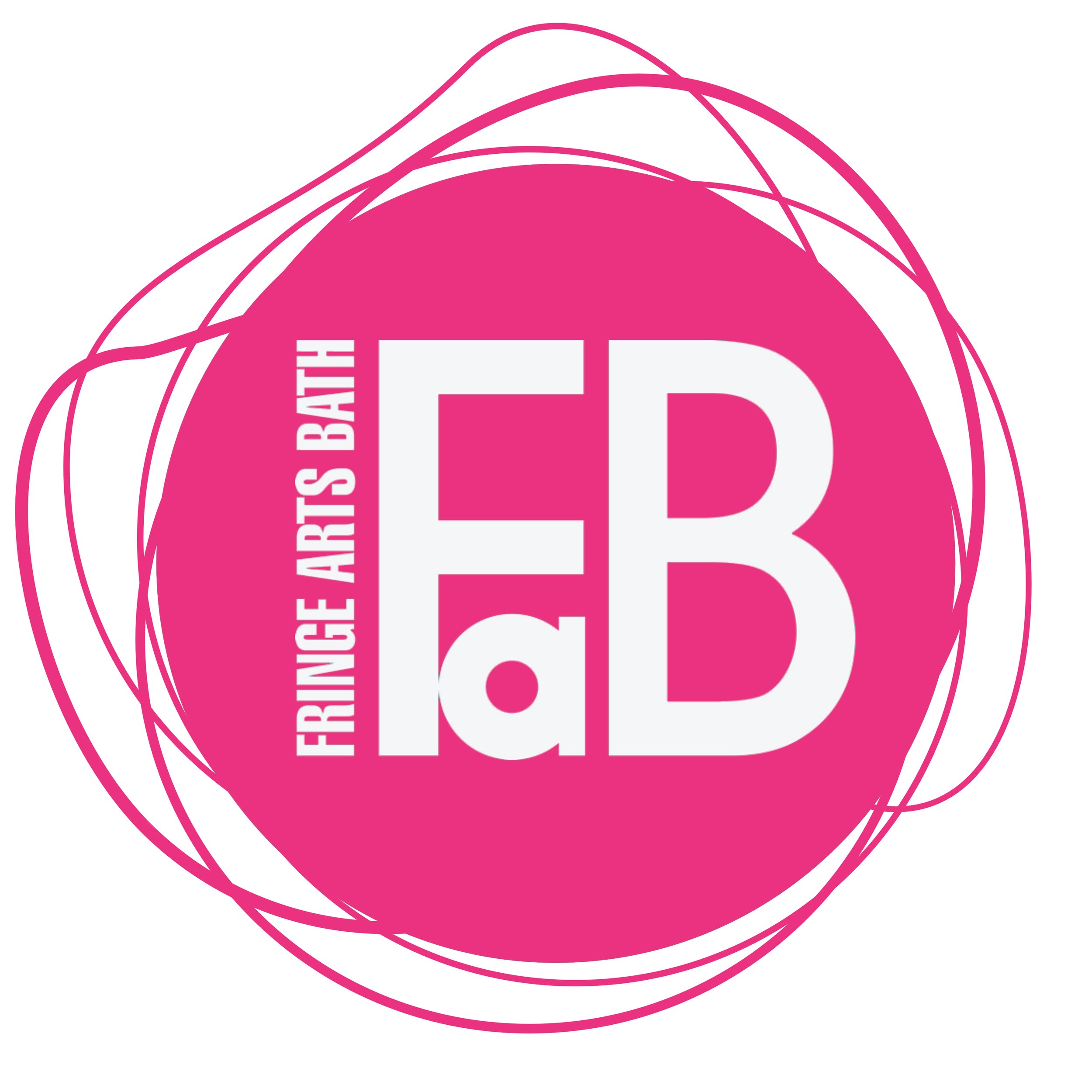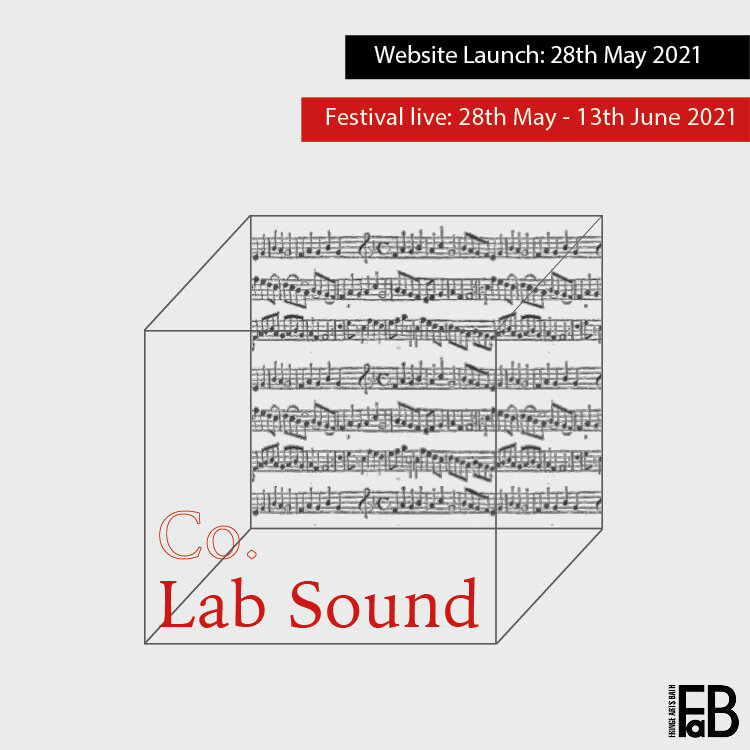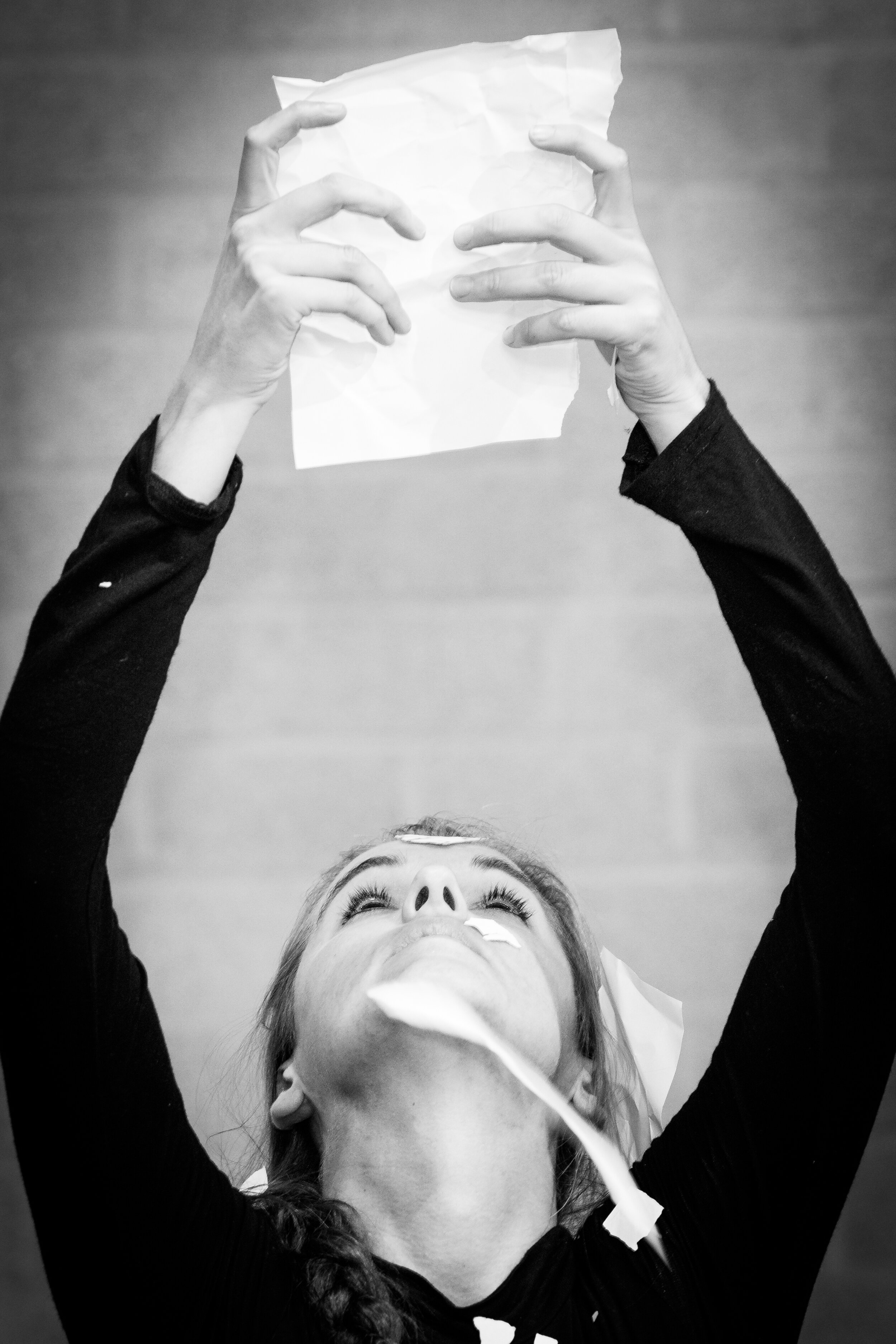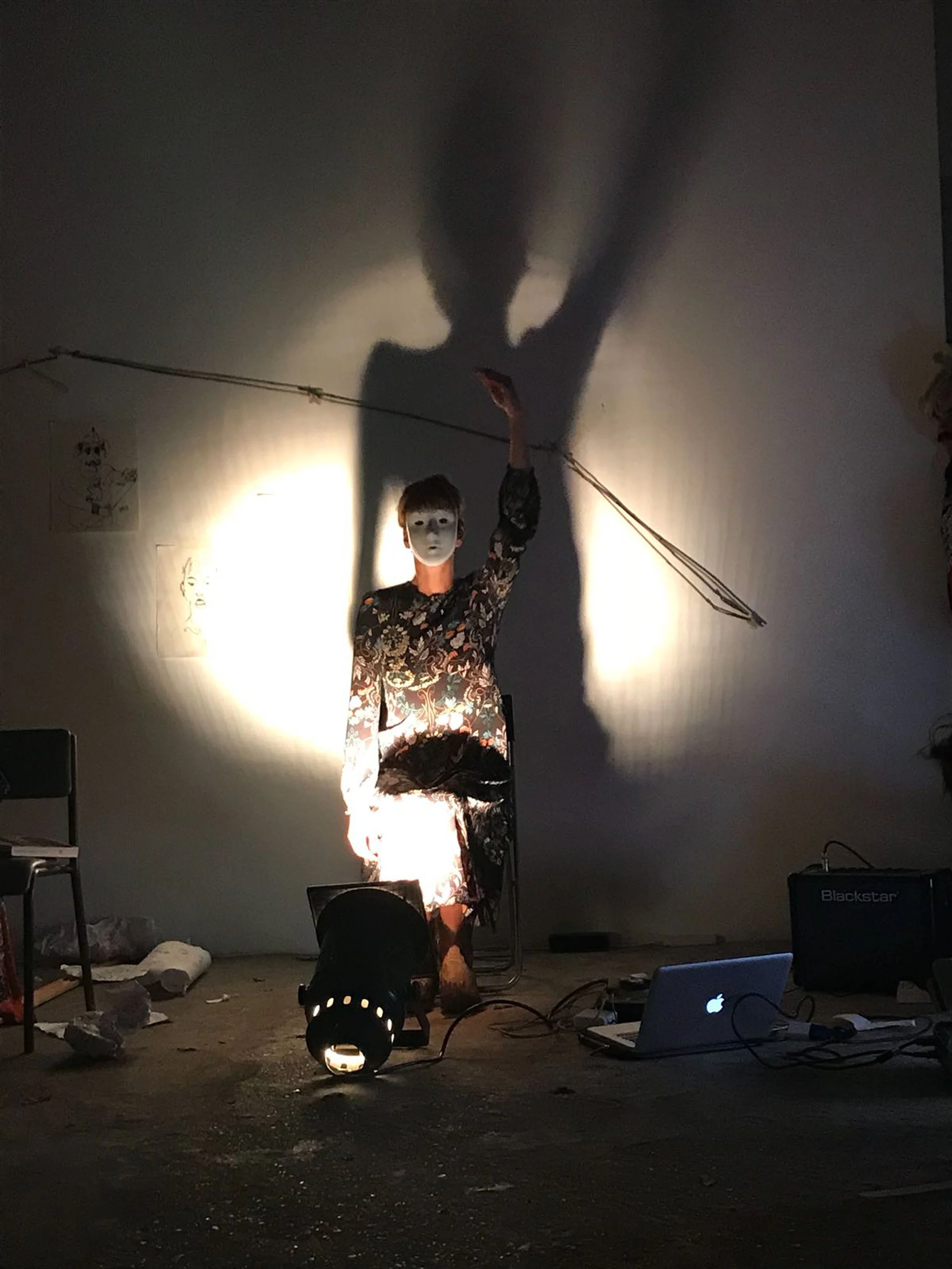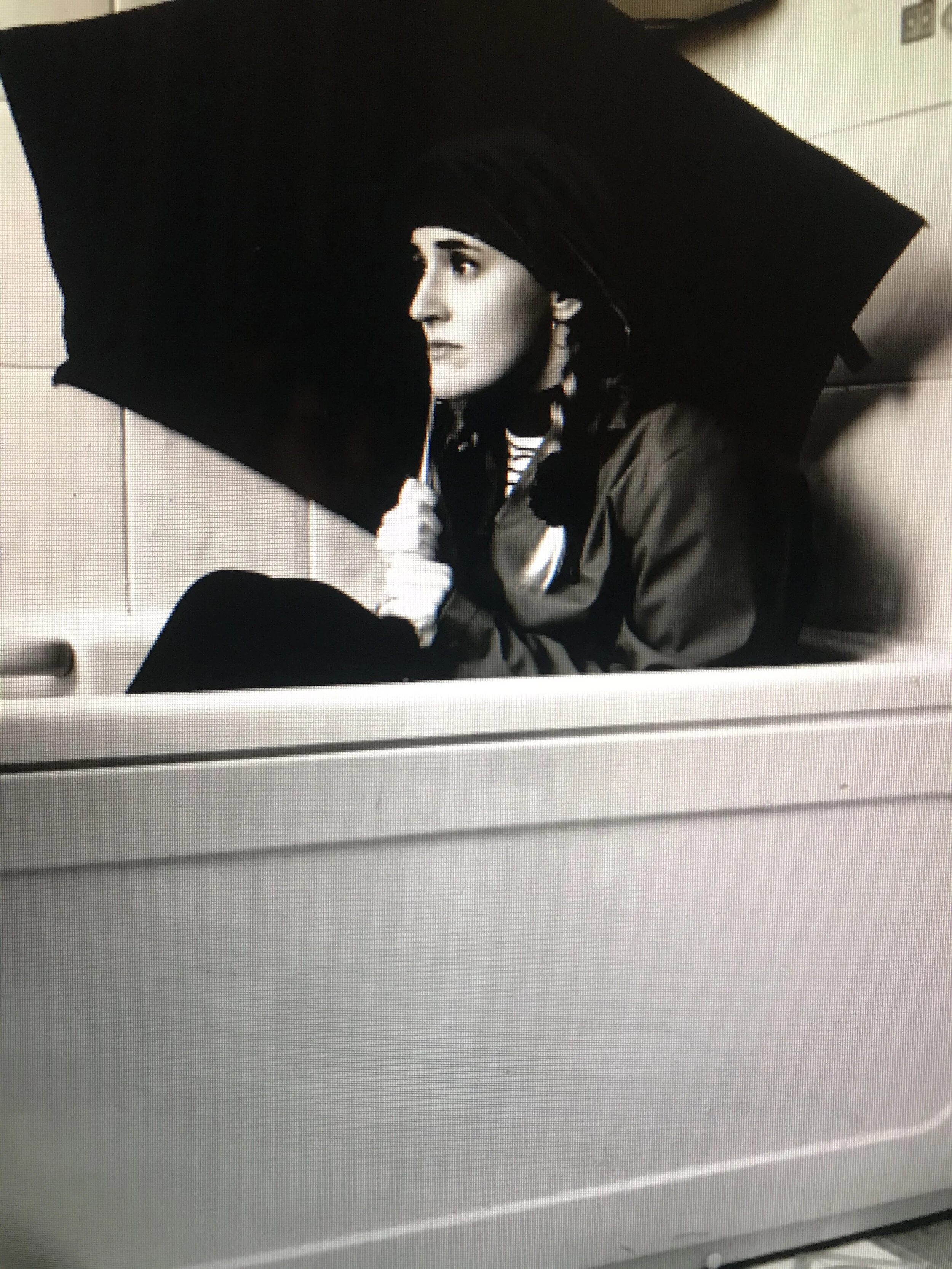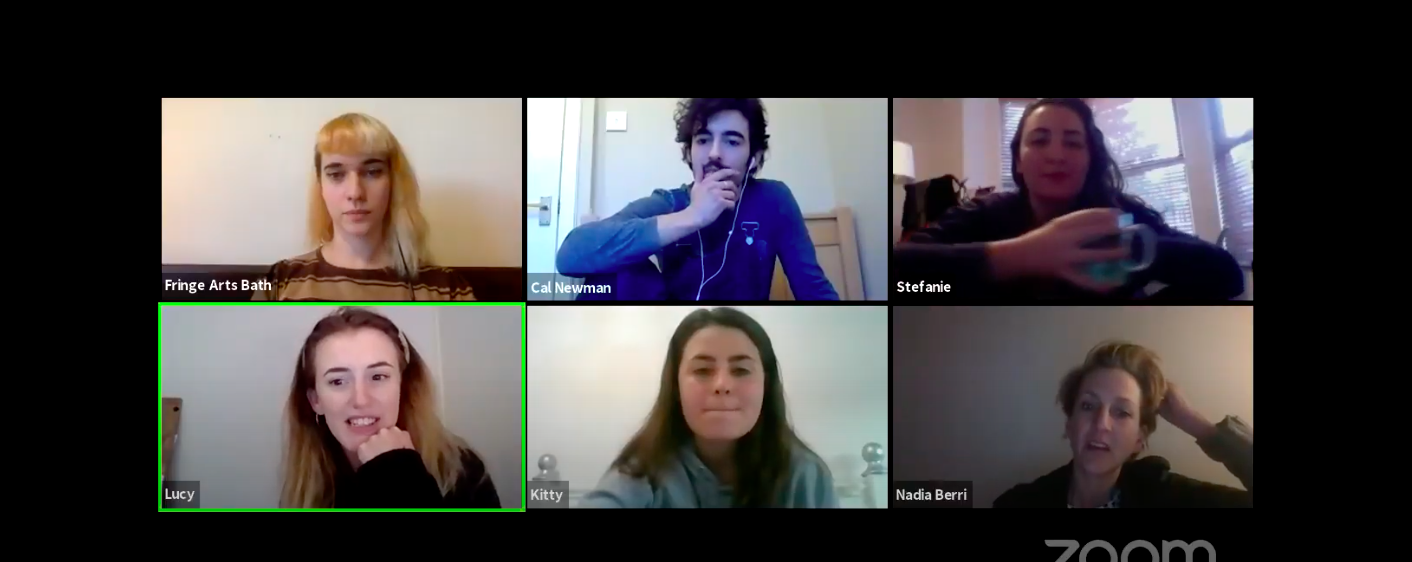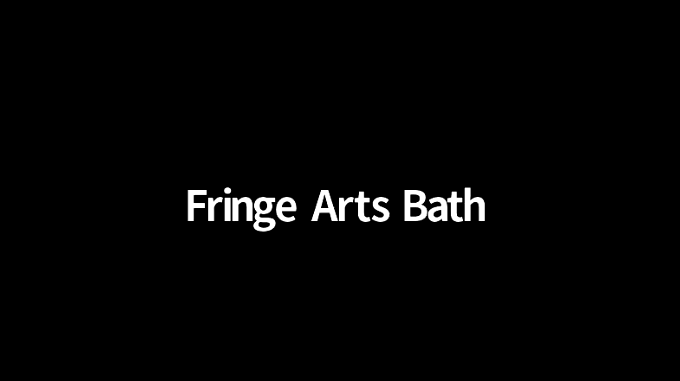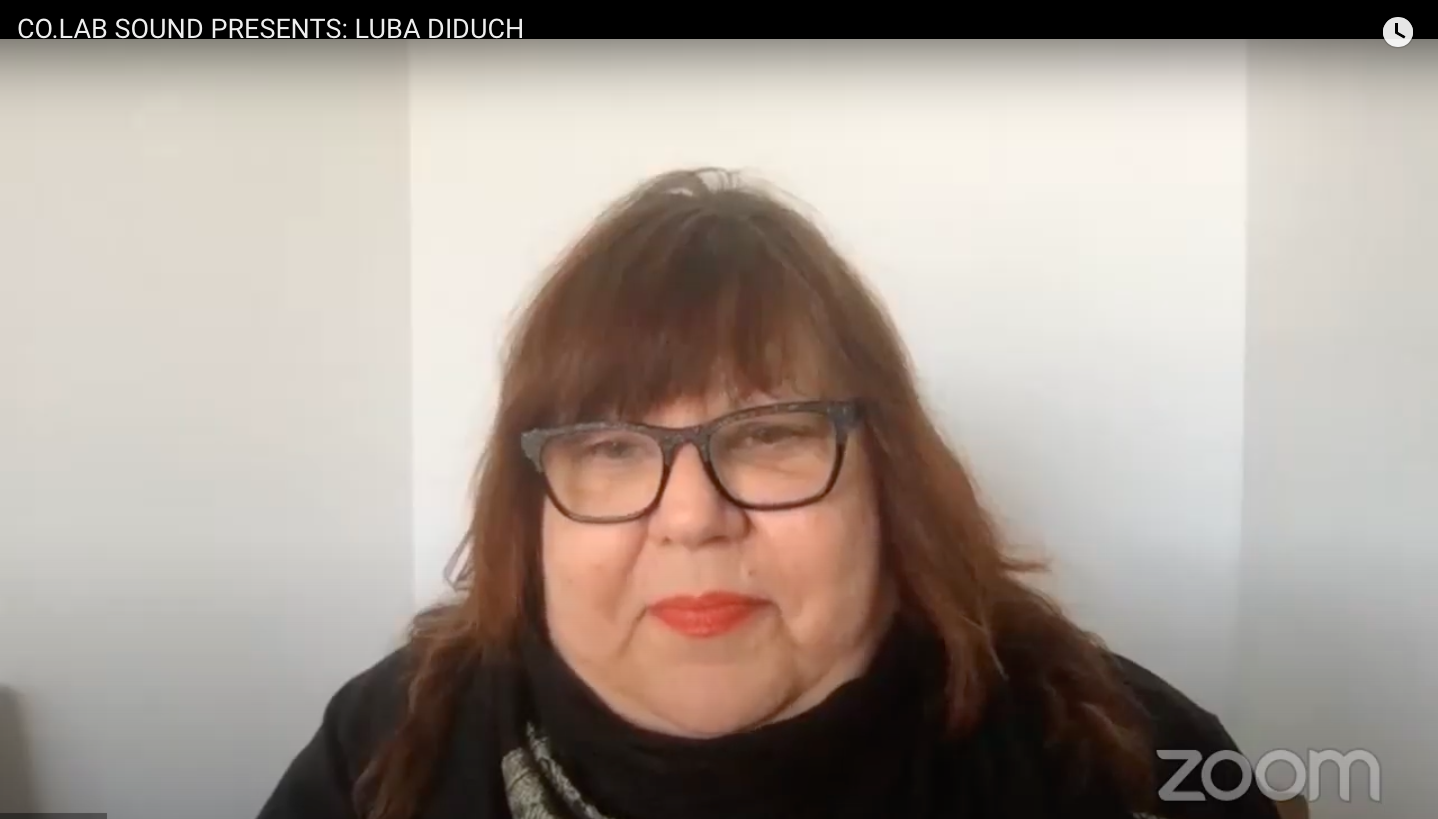Co.Lab Sound
Co.Lab Sounds is back again with Fringe Art Bath for their 2021 festival!
Co.Lab Sound is an experimental testbed for artists to develop new work and collaborate live. Informed by a long line of experimental music, sound art and performance, these events embrace the processes of improvisation and experimentation to showcase artists expanding the field of sound art and what it means to experience art live.
Performing is inherently participatory, our aim is to develop a new dialogue between the audience and our exhibiting artists, collectives and musicians by making the audience a part of the making process. We encourage the disruptive, the active and outspoken. Take part, take in and be live.
Co.Lab Sound: Collaborative Practice & Workshops
Workshop:
Participatory Practice In Time Of Social Isolation
exquisite Corpse 2.0
Follow along during the FAB 2021 festival as Co.Lab artists create new collaborative works responding to digital and analogue techniques.
Co.Lab Sound New Developments 2021:
The Cyborg Art Collective
Glitch Swap
On the 13th of May 2020 the Cyborg Art Collective joined the Glitch Swap generative art Game started by Orlando Mee and Lee Shang Lung, in which we collaborated with Data Bosma, Bjørn Magnhildøen, Jaime de los Rios, Charles M. Alan & Mark Schobben. The band named Signal Orange & the Color Blind was started as a spin-off of this collaboration on the 15th of July 2020.
The Crackheads with Pianos
Seeing as digital data in its bases can be read as a numeric structure we explore the possibility of converting this information into musical patterns. Knowing that music can be analyzed mathematically, a link can be created in which any form of digital data can be transformed into a musical order. With this method Signal Orange & the Color Blind lets the data determine the composition of every song.
le Cadavre Exquis volume 1:
For the Fringe Arts Bath festival in 2020 the Cyborg Art Collective joined the exquisite corpse project started by Co.Lab sound. With this project we used the Cadavre Exquis method developed by the surrealist movement with which we produce 122 different artworks. For the le Cadavre Exquis these files were used as a starting point to create music. Using our online platform [ https://sigora.cyarco.com/lecadavreexquis/ ] we set out to produce various albums for the le Cadavre Exquis series. With this website anyone from our group can start a track by selecting one of the files from the 2020 Exquisite Corpse project, download it, and use it to compose a musical track. After uploading it back to the platform anyone can pick up this track and continue the composition.
Le Cadavre Exquis is a collaboration between: Charles M Alan, Luba Diduch, Orlando Mee, Neil Milton, Ally Poole, Mark Schobben
Claude Heiland-Allen
Claude Heiland-Allen is an artist from London, UK interested in the complex emergent behaviour of simple systems, unusual geometries, and mathematical aesthetics. From 2005 through 2011 he was a member of the GOTO10 collective, whose mission was to promote Free/Libre Open Source Software in Art. Since 2011, Claude has continued as an independent artist, researcher and software developer. His current main projects include various deep zooming tools for 2D escape time fractals (et, kf, zoomasm), musical performance live-coding in the C programming language (clive), and a postfix bytebeat/rampcode
music system with a collaborative web-based interface based on Etherpad (barry).
Rodney
In the early 1980s, industrial research super-computers were used to generate images of the Mandelbrot set, the most famous mathematical
fractal. With the advances afforded by Moore’s law, the 1 gigaflops of the 1980s super-computer is now (in the early 2020s) left behind by consumer hardware over 100 times faster. Benoit B. Mandelbrot’s ideas about roughness at all scales being a relevant way to describe and quantify shapes found in nature quickly found their way to the art world. With limitless visualisations of chaos and the infinite, the question now becomes: where do you want to go today? The fractal
explorer bot Rodney attempts to automate an answer, using mathematical models to quantify fractal image aesthetics it navigates to places it considers beautiful, and hopefully the humans watching may agree.
Nadia Berri
Doing 'käfig' alone: one of three studies exploring of how I can collaborate only with myself, without the usual collaborators that have appeared in past käfig performances nadiaberri.live/about-1. Meditating and responding to an abstract painting by my friend Yvette Blackwood, literally moving all shapes, forms, directions, colours and materials in the work. Twice, once without any other material, and once with my simple 20 meter black nylon strap, performed to camera, then edited together as a 'duet with one body'. The spoken word text is randomly chosen - in the style of Tristan Tzara and the dictionary - from Antonin Artaud's 'The Theatre and its Double'. It strangely resonates with what is happening in my movement as well as in the painting (which you cannot see).
Doing 'käfig' alone: one of three studies exploring of how I can collaborate only with myself, without the usual collaborators that have appeared in past käfig performances nadiaberri.live/about-1. In this second study I translate Richard Serra's 'Verblist' (1967/68) into movement. Serra famously said, "Drawing is a verb." In 'Verblist', he compiled a series of what he called "actions to relate to oneself, material, place, and process.", a concept that I explore in my own practice. In 'verblist quintett' I juxtapose different immediate responses and performances to camera, layering live performance, projections and in-camera editing on top of each other to create a quintet with one body. The soundscape, nothing to do with anything previously mentioned, but rather randomly chosen and strangely working with the rest of the material, is Ned Sydney Prevezer's 'brutal' one of four soundscapes he created for my project 'water returns to brutal form' 2020.
Doing 'käfig' alone: one of three studies exploring of how I can collaborate only with myself, without the usual collaborators that have appeared in past käfig performances nadiaberri.live/about-1. 'walking' began with urban detritus and views encountered on my street. The material was then translated into spoken word and movement and finally the three were collaged together to create a 'ballet' of words, objects, views and choreography.
Laura Netz
MDA
Neil Milton
Neil Milton is a writer and artist. Developing on his fine art practice, his latest works explore audio-visual media. Inspired by collage, experimental film, expanded cinema and VJing, his work is a dialogue between the elements of sound, image and textual language. In particular, he explores the relationship between words and their sonification, text as semantic signifier and aesthetic image. Previously immersed in club culture, thematically he is engaged by issues of substance, altered states, spiritual transcendence, meditative bodily expression, and furthering communication. He is also interested in the therapeutic aspects of sound and its use as a medium for exploring ‘ill’ mental states.
Exp Film 1 - was an exploration of using live filters, combined with exposure effects, without the use of software filters. The sound elevates it from a visual experiment to something else altogether.
Exp Film 2 - is also an experiment in live filters and abstraction. However, combined with the sound and the reversed image, it is evocative of nitrate film combusting - a reference to the legacy of filmmaking - whilst also an elemental switch. The sound was mismatched to the image.
Exp Film 3 - is an experiment in the perception of time. By overlaying an inverted video of birds, running in reverse, over one in forward motion, it questions our relationship to moments. Also an experiment in abstraction, the soundtrack is made completely from the sound of birds taking off.
Exp Film 4 - is an experiment in time and the relationship between sound and image. Through recording moments, we are able to control ‘reality’. This rendering of actual life into media gives the filmmaker a sense of agency that otherwise might be absent in life. By combining the image with electronic sounds it emphasises this relationship, rendering the subject an avatar as it mimics a computer game.
Exp Film 5 - is an extension of experiment 3. It is also an experiment in time perception. By overlaying two train journeys, simultaneously playing forwards and backwards, it evokes continual quotidian repetition of our passage through life. The gradual progress of the narration emphasises the content of the text and creates a hypnotic sense of anticipation. The overlaying of narration in forward and reverse mirrors the images.
Exp Film 6 - is a virtual self portrait of the artist and snapshot of a moment in time. It is a comment on the primacy of the recorded image and the unknowability of the recordist in their absence. It encourages the viewer to perceive with their imagination not what is immediately before the camera but what is behind.
Co.Lab Artists:
Ally Poole
Ally Poole is a multidisciplinary artist working between the US and the UK. Her practice is an exploration of being both performer and sound artist. Ally's solo work is a blend of live art, theatre and installation while covering issues of race, politics and pop culture through her perspective as a Black American.
Barry Despenza
Sound, Moving images and space are foundational cornerstones for my practice. Whether that is an emotional space or an architectural one, My aim as a sound/video artist is to make visible the imperceptible and to make the visceral become intangible. You will find that my work is centered on power structures that underlie the perception of what it means to be visually stimulated.
"Fractured" - 0:48 , AudioVisual
”It Ain’t All Good” - 1.17, AudioVisual
"The Medium Is The Same Message" - 1:25, Audiovisual
Camilla Nelson
Camilla Nelson is a British language artist, small press publisher, creative programmer and freelance academic with a PhD in Performance Writing (Falmouth/Dartington, 2012). Her work explores the materiality of language in page-based poetry, soundwork, installation and performance.
A Yarn Er Narrative started life as ‘paper trail’ - an installation of approximately twenty site-specific pages and numerous paper fragments, constructed out of and in response to those particular sites, for Karen Pearson’s outdoor exhibition 'Assemblage: Narratives in the Managed Landscape' in Yarner Wood in Dartmoor (Devon, 2012). paper trail’s later stages of decay were exhibited in in Amy Cutler’s Time, the Deer, is in the Wood of Hallaig in St John’s Belfry, London, as ‘The Forest Writes Itself’ (2013). Full details of ‘How to Make a Yarn Er Narrative’ form the centre page of the poetry collection published by Contraband Books (2019):
How to make A YARN ER NARRATIVE
(remnants of a paper trail)
STEP 1: Visit Yarner Wood on foot. Walk to locate particular sites of interest.
STEP 2: Photograph each chosen site.
STEP 3: Take material samples from each selected site e.g. plant matter, earth, fungus.
STEP 4: Once home, link photographs with material samples. Reduce number of sites to a manageable quantity. Research: etymology, biology, geography, history.
STEP 5: From this research, select text from which to form a site-specific poem for each site.
STEP 6: Mulch materials from each site with print outs of site-specific text to make a paper pulp. Make a new site-specific page from each set of site-specific materials.
STEP 7: Tear fragments from printed texts to overlay onto each remade page.
STEP 8: Return each site-specific text to the site from which it first emerged.
STEP 9: Photograph each page in place.
STEP 10: Leave pages on site for a week.
STEP 11: In a week’s time, return to photograph remaining text.
STEP 12: Collect & store remaining text.
STEP 13: Create new poems from the mulch of remaining materials.
A Yarn Er Narrative now exists in print (Contraband, 2019), in soundwork and in live performance. In print, the book can be read from both ends. One half of the book includes visual treatments of the composting text. The other half presents the poems in standard print. The soundwork exhibited here for Co.Lab (FAB 2020) reads the process of physical decay (visualised in the images of the composting texts) through the printed poems to create an audible rendering of literary decay. A Yarn Er Narrative (soundwork) celebrates the myriad sounds that make up a word. Only when they begin to fall apart do we realise quite how beautiful, complex and intricate woods/words/worlds really are.
Duration: (30 mins)
Claude Heiland-Allen
Claude Heiland-Allen is an artist from London, UK, interested in the complex emergent behaviour of simple systems, unusual geometries, and mathematical aesthetics. Since 2005 he has been using and creating Free/Libre Open Source Software to support his artistic and research practice. https://mathr.co.uk
Dynamo
Material: generative audio work
Duration: indefinite
Website: https://mathr.co.uk/dynamo
Description: Dynamo creates music from carefully controlled randomness using numbers to invent harmonies, melodies, rhythms. Dynamo is implemented in the Pure-data dataflow environment for multimedia. This version is compiled to run inside the web browser using empd, a combination of Emscripten and LibPd.
Disco/Designer
Material: interactive audio work
Duration: indefinite
Website: https://mathr.co.uk/disco/designer
disco/designer is a rhythmic noise instrument. disco/designer emerged from research into audio finger-printing using Haar wavelets. Haar wavelets provide a computationally cheap method of finding the energy in each octave band of an audio signal. Applying the algorithm again to the energy values over time provides rhythmic information. Theresearch aimed to discriminate between different kinds of audio (speech vs music, for example) by comparing their rhythmic finger-prints. disco/designer allows you to draw a rhythm-print with the mouse or touchscreen (clicking above the grid points increases the value, below decreases). Left to right corresponds to low to high pitches, bottom to top corresponds to slow to fast rhythms.
Puzzle
Material: recording of generative audio-visual work
Duration: 10 minutes, 1920x1080p60 video, 48kHz stereo sound, 200MB
Website: https://mathr.co.uk/puzzle
Description: Sliding tile puzzles have existed for over a century. The 15-puzzle craze in 1880 offered a cash prize for a problem with no solution. In the Puzzle presented here the computer is manipulating the tiles. No malicious design, but insufficient specification means that no solution can be found; the automaton forever explores the state space but finds every way to position the tiles as good as the last. . .Each tile makes a sound, and each possible position has a processing effect associated with it. Part of the Puzzle is to watch and listen carefully, to see and hear and try to pick apart what it is that the computer is doing, to reverse-engineer the machinery inside from its outward appearance.
Ken Byers
Ken Byers is a digital media artist and has a techno-romantic approach to body and technology, perception and the human condition, crossing between science, technology and philosophy, through embodied-interactive 3-D audio-visuals, 3-D animation and sound, film, VR, experimental sound, new media.
An aspect of my media and interactive work incorporates transferring movement data to computer sound creation, using computer vision and sensor technologies, transferring natural and human movement to digital visuals and sound creation.
Embodied Interactive Audio-Visual.
This is a user-experience body- interactive audio-visual. Head, shoulders, arms, hands, hips, are linked to moving body data in a 3-D space. Moving body data, is then passed to 3-D objects in space, analogue synths and filters for live decoding in visual audio surround. Best experienced with semi-surround screens and surround sound for dedicated audio channels for interaction.
Luba Diduch
My art practice uses the soundwalk as a means to capture natural sounds in forested environments. A soundwalk can transcend the sounds that we hear in the environment – it can become a psycho-geographic layering of sounds heard in a space -- as well as the imagined sounds stimulated by the experience. This is reminiscent of the ‘dérive’ that Guy Debord (a situationist) wrote about in his paper ‘Theory of the Dérive’.[1] In relation to my current work in social isolation, these imagined sonic experiences have created nostalgic feelings for me and a longing for the sounds of the wilderness that I cannot experience at the present time.
A soundwalk can be seen as an event that enables the artist's imagination and inner worlds to manifest themselves. A soundwalk can tap into the powers of spatial imagination while the artist moves through a forest space, for example. It becomes both a situation where the artist records sounds through creative activity and at the same time experiences a unique series of events.
[1] Debord, Guy (November 1956). Translated by Ken Knabb. "Theory of the Dérive". Les Lèvres Nues (9).
Duration 5:01.
A recording that was made underwater where the Bow and the Spray rivers meet in Banff National Park. If you listen closely, you can hear bubbles popping — these represent the sounds of curious fish gathering around the microphone. You can also hear rocks and boulders sliding against each in the river’s current. This piece was recorded using a hydrophone.
Duration 2:29.
This is a recording of aspen trees in the wind, river currents and sounds of animals. It was recorded on the banks of the Bow River in Banff Alberta Canada. I arrived at the recording site on the day, thinking the forest would be still and quiet during the eclipse. In fact, prior to the eclipse event, the forest was very much alive with a great deal of sonic activity.
Duration 8:09.
This is a recording made by the river on a warm summer's afternoon. That same day, I found a red-tailed hawk feather on grounds that are sacred to the First Nations Indigenous people of Canada. I made a drawing and photographs of the feather. Coincidentally, I encountered a red tail hawk flying overhead later that day by the river. The discovery of the feather, along with the experience of witnessing the hawk's flight showed me new ‘edges’ or ‘boundaries’ in a serendipitous narrative that I had not previously considered as I traveled through the forested landscape.
The Cyborg Art Collective
The Cyborg Art Collective is a collaboration between different artists from various places. For every project the participants vary, and the group is not based in any particular location. The collective's aim is to create works that mediate between different discourses, fields of study and the general culture. All projects are primarily research and experiment based, and focus on philosophical and scientific questions surrounding technologies' role in everyday life.
When exhibiting at events like tech-conferences as Toronto Digifest, art fairs like In Situ Art fair and Vita Tua, Vita Mea and festivals as Gogbot and the Dutch Design week, the engagement of the audience is crucial. An Interactive installation like The Ultimate Exhibition for example provides a tactile aspect to a gaming experience. And performative installations like Project Key Code can be used to provide a layer of expression to a digital dialogue. By actively involving the audience the Cyborg Art Collective provides them with the means to experience and actively engage with the subject matter. Generating knowledge and insights on the concepts and the qualities of the technologies involved. And to provoke questions and discussion on these topics to further understanding on the matters in question.
Project Key Code, Total Lockdown edition
Digital communication technologies have become an important cultural component in today's society. Project Key Code looks at the specific part the keyboard plays within the interaction through digital media. When comparing a verbal dialogue with text based communication the question of how the aspect of expression compares arose. Due to the control a keyboard provides, an expression in text can be much more tailored to fit the individual's intended meaning. While a verbal dialogue and the other hand is more subject to the emotional state of the individual. This is not only because of the non verbal aspect of facial expression and body language. But also the, sometimes unintended, influence that things like intonation have on the ulterior meaning of the spoken words.
Exploring this aspect, Project Key Code developed into a platform in which music serves as a communication tool. By using velocity sensitive keyboards the communication through notes and chords introduces a certain uncontrolled input to a dialogue. As the same letter can be typed in with different velocity it will convey a sense of expression.The translation of chords to letters also provides the possibility to express the same message in different ways through the variation of chords. A minor-, major or power chord standing for the same character in the alphabet gives the option to say the same thing in a different tone. And the tone of an expression can also be varied with the pitch. By sending the text and sound between the different locations Project Key Code became a combination between dialogue and musical composition that gives expression to a digital conversation.
The total lockdown edition of Project Key Code is an online adaptation in which musicians can log into their accounts to join the performance/dialogue. This version has become more open to experimentation in which participants can use various instruments to add an extra layer to the conversation.
3D sound space
The spatial aspect of sound is often not present when using online media. While playing audio and video on websites and streaming platforms the audio channels are more static in their orientation. To get a more spatial experience a three dimensional virtual environment provides the possibility to give direction and depth to sound. In this way artists are given the possibility to build a virtual sound installation which can be viewed by the audience in the way an online computer game would be played. Providing an immersive online sound experience that explores the dimensionality and interactivity virtual reality facilitates.
Nadia Berri
Nadia Berri is a Swiss multidisciplinary artist based in London working in sculpture, choreography, drawing, language, film and sound.
Her interests lie in disparate materials and situations and in her practice she brings things and people together in theatrical, often absurd scenarios intended to mess up a fixed idea of reality.
Berri conceives and choreographs sur-realities that go under the name of 'käfig' - unscripted sculptural plays that evolve using chance methods and material improvisations. 'käfig' performances are composed and produced live on 'stage' without any pre-existing narrative. Performing in all kinds of locations - derelict buildings, car parks, living rooms, street corners, project spaces, parks. Launderettes etc. - they use disparate objects, movement, sound and language as sculptural materials in a nonhierarchical manner and form a new whole and that taps into the subconscious. No performance of käfig is ever the same and collaboration is key. (www.kafig.live).
'käfig: water returns to brutal form' is a beckettian visual/audio poem-performance in the form of a film-collage by multidisciplinary artist Nadia Berri.
Berri has invited Manchester School of Theatre students - now isolating in different parts of the UK - and asked them to respond to four words: water; return; brutal; form. This disparately devised material has then been choreographed by the artist into a new whole.
Starring: Marley Brown, Laura Masters, Kitty Watson, Lucy Carter, Cal Newman, Jake Cooke, Stefanie Hammoudeh, Casey Erickson, Matthew Leaman, Jack Moorby and Amelia Cox. (All Manchester School of Theatre, 2nd Year) With contributions from Nadia Berri, Jade Wilford, Ned Prevezer and Jakob
Duration: 45 minutes
Neil Milton
Neil Milton is a writer and artist. Developing on his fine art practice, his latest works explore audio-visual media. Inspired by collage, experimental film, expanded cinema and VJing, his work is a dialogue between the elements of sound, image and textual language. In particular, he explores the relationship between words and their sonification, text as semantic signifier and aesthetic image. Previously immersed in club culture, thematically he is engaged by issues of substance, altered states, spiritual transcendence, meditative bodily expression, and furthering communication. He is also interested in the therapeutic aspects of sound and its use as a medium for exploring ‘ill’ mental states.
Above: Not SIlent Poetry - A looped multimedia installation, the work is a dialogue between digital video, projection and audio. The work alternates between a video of a sign-language poet reciting a poem; an audio file challenging the primacy of communicative modalities; and a projection of lips silently conveying a related theoretical text. Through the use of subtitling, the work highlights the difficulties of understanding sign language to the uninitiated, and the unreliability of lip reading for both a deaf and hearing audience, whilst exploring the process of interpretation and translation.
Drawing on the theoretical writing of Jacques Derrida, in ‘Of Grammatology’, it challenges the phonocentric view of language that people can only truly express their fundamental humanity through the voice, which excludes non-vocalic languages, such as sign-language, the modality of deaf communities. Unwittingly, this is an example of ‘audism’, a concept coined by the scholar Tom Humphries in the 1970s. By limiting the translation in parts of the work, it highlights the importance of accessibility within society, to prevent social exclusion, whilst bringing linguistic discrimination to the foreground, as well as confronting our reliance on hearing through impaired sound.
Below: In the Seat of It - a sonified poem from my audio collection of poetry 'Paperstrong'.
Roy Boswell
Roy Boswell is a half-Finnish, half-British artist and writer from Helsinki. His work is usually time-based: performance, audio drama, sound art, text, moving image and ceramics.
ALPHABET
26 stereo audio files / 53’21”
27 video files 53’59”
‘Alphabet’ is a 26 part audio work which constructs a vocabulary, or reality, of its own. It consists of jumbled up pieces of stories and descriptions of the voices of people and animals, and other things, which might all be the same in the end.
In early 2018, a friend told me he wished he could turn into ashes, and that I could then carry him around in my back pocket in a little ziploc bag. I think he wanted to be contained or held. I thought the idea was really nice, to be able to change shape and be a powdery substance, and then having bits of lint or dust mix in – and what would he be then? A dusty, linty version of himself? And if he was a fine powder, maybe I could be, and other people and things could be too, and we could all get mixed up together. What would I be then?
I decided to try to write dialogue in these ash voices, where a single voice may contain many or all voices, or all voices could potentially contain every individual voice of everything, across all time.
I chose the form of an alphabet early on, partly because I thought the structural rigour would help me write for the voices, but also for its being the constituent parts of (this) language. We can use language as a container of things. It can help us collectively or functionally agree on what things become established; things like spoken language, or, say, the shape of the letter ‘a’, or the order of letters in an alphabet, or which parts of history we decide to make canon and which ones to suppress. The evolutionary development of languages, how communication has worked throughout known history, coincided with my thinking about ways of making structured vocabularies for performance – something I was very interested in at the time. Realities that may be built up in rehearsal or collective imaginations, that make sense within the context of the work, but require that specific environment to flourish. Language and writing are realities in themselves, shared by those with a given form of communication in common. Language creates reality, and in some intimate, imaginary way – between the two of us – my friend had been in a ziploc bag in my pocket, simply because we had both visualised it.
Language is a manifestor or a spell, in the sense that it has the power to make things real.
Language is a container, both in the sense that it regulates how things can be said, and in how it can enclose and frame the realities it creates.
The constraints of an alphabet (the set number of symbols, their specific order) form an evenly spaced framework. I wondered about things that fit into such frameworks and things that betray, contort or subvert them. I found myself wondering at the complexity of natural sponges in an art supply shop in Bristol. The way the sponges feed, by passing sea water through themselves and filtering out nutirents, for example, was an obviously similar function shared with the way humans and other more complex life forms take nurtition. What else do we have in common? What makes us separate? I remembered reading about an experiment in which two different types of sea sponges were put in a blender and then pulsed into a fine mush. The particles of the two sponges proceeded to reorganise themselves, growing back again as two separate entities. One sponge can also exist in more than one place at once; the multiplicity of a single entity being able to exist at touching distance to a copy of itself, the only difference between them being that one is younger, and the other is older. When I first met the artist Flis Holland, on a phone call, I initially thought I was speaking with educator and translator Flis Kjisik, at the time the only person I associated with having the unusual first name. Both Flis and Flis happen to be from the North of England, living in Helsinki, but one is approximately half the age of the other. I was very fortunate to be able to record with them both for the alphabet, two years apart, one in 2018 and the other in 2020.
Sea sponges crept in elsewhere: as part of a residency at the Elektronmusikstudion Stockholm in 2019, I used needle-shaped sensors under my skin and in the tissues of sponges to send control voltage to a Buchla modular synthesizer. The weak electrical signals that occured through interactions between myself and the sponges produced sounds – recordings of which feature here. In fact, almost all sounds in this piece (apart from Flis Holland’s and Flis Kjisik’s voices and a little bark and a growl from Elia the dog) were made using modular synths, another kind of new language to me. The modular synths (a vintage Buchla in Stockholm; Julian Parker’s Eurorack system in Berlin and another in Helsinki) were all recorded in 2018-2019. Some additional software synthesizers (VCV Rack and Madrona Labs’ Aalto) were recorded at home in Helsinki around the same time.
As a textual representation of the ever-changing way that language is used, I wrote some parts of the alphabet in ‘greentext’, a simplified, highly stylised format that started on 4chan some time in 2010. Greentext usually begins by introducing the anonymous narrator / focus character, followed by age or other signifier, before continuing with the story, written in short, clipped sentences. It mostly leaves out self-referencing pronouns (apart from the first line), and interjects filenames within the text which act as replacements for more descriptive passages (a simple ‘image.jpg’ can be quite evocative):
> be me
> 19.000 years old
> computer prints out character after character in Linear B.
> ancientminoan.docx
> ashes swirl in ceramic or bronze bowl
> ashes are kept in urns
> greekvase.bmp
The very first part of the alphabet was written in summer 2018 during a residency in Luxembourg for a contemporary dance piece that I was working on at the time (‘For God’, with choreographer-performer Soili Huhtakallio & co., premiered at Zodiak Centre for New Dance in February 2019). The performance discussed ideas of religion and religious belief, and the giving up of the self to a higher power. While I am not in any way religious myself, I have a lot of respect for religion and the important part it plays in people’s lives. I believe that religion is important in the same way that language is; another way of framing the world and giving life context, logic, and a path – perhaps from A to Z. I wrote about making contact with a god and about becoming consumed by it. The more formal story (which comprised of an exposition, section of rising action, climax and resolution) provided a narrative line in the midst of what would later become the more disparate sections within the text.
I never was able to write in the voices of the ashes, in the end. The closest I got was a simple greeting, a “hi” buried somewhere in there, but maybe that was enough.
The photographs of sea sponges by zoologist Henry Frank Moore which feature in the video version of the alphabet were originally part of a report to a fisheries commission in 1908 (and are now public domain). Moore’s images have followed with me throughout this two-year process, and they remain some of my favourite photographs.
This alphabet is meant to be played in any random order, and I suggest either turning on shuffle in the Youtube playlist, or downloading the files from Bandcamp (the files are available for free) and then playing them in any random order on your computer.
A boxed art book edition of the alphabet will be available in early June.
‘Alphabet’ was voiced by Flis Holland and Flis Kjisik.
Special thanks to Emily Boswell, Noora Palotie, Pia Parjanen-Aaltonen, Julian Parker, Eero Pulkkinen, Greta Salonen and everyone at Elektronmusikstudion Stockholm.
Title: Silé
Duration: 40 minutes
Theme : domesticity, mind and sound
Synopsis: Silé is a sound art and participatory performance Art. Fusion of music creation with domestic objects and poetry. It encompasses examination of the connection of domestic condition and the Human mind.
Silé is a Yoruba word from the western part of Nigeria Africa that loosely translates in the English language as " settlement". For instance, there is poor electricity in my country, where citizens have to create power through generator and noise pollution everywhere. Presently this act has become a norm in every environment. However, Silé should aware the people about the connection of the domestic condition and our minds.
Sinmiloluwa Oyewale
I am a performance artist. I perform to promote the human spirit. My works has involved creation of conceptually based sociopolitical objects and sound art. I started protesting art few years ago. Fusion of rare African traditional music and modern electronic sound. As time pass by I began to use poetry, movement and object based concept and that has now become a prominent feature in my work. In my works, I deconstruct the conventional approach to contemporary art in Africa. My works also address social justice, people behavioural pattern, demolition and gentrification. Often times these themes are combined into bodies of work that express my criticism and true perception on social issues.
I have done a couple of conceptual art in the past. I also create site specific concert. A deft blend of music and conceptual art. It promotes non conventional space for concerts. This has been one of the uncommon ways i express myself as a thinking artist. And it is also a natural way to keep my protesting art alive in the face of the people. These days, I sense my mind is occupied. It is floating within a sphere of time and nature based art.
This is an art intervention that takes it inspiration from bojú bojú. Bojú bojú is a Yoruba term that denotes both, a children rhyme, a song of praise, awe and respect for one of the Nigeria’s vast rich culture, as well as children’s game, which loosely translates as “hide and seek” into English language. Mask, masquerades, spirit and ancestors are inherently linked to concept of bojú bojú and this is where our project takes off. We are creating stories around Nigerian mask that has travelled through different hands and have been removed from their context. Masks that are kept and exhibited in public museums across the world.
Yet, the theme our project addresses is twofold: it is as much questions concerning reparation of African art and craft, as it is about the systematic neglect of our own history as illustrated by the deplorable state of artifacts, art centres and museums in Nigeria.
The aim of our project is to raise questions and to open space for discussion. We do acknowledge that the keepers of Nigeria arts safeguard them as archival materials and recognise their value. However, do they truly understand the cultural context and practice that surrounds the masks?
Put differently, if the mask that are held in museums in Europe and North America should wake up and walk through the city, how would people respond.
This is an interdisciplinary and participatory art intervention taking place in the street of bariga, Lagos and is comprised of live music, live painting, live video-art and dance theatre.
The project methodology is based on notions of archiving and archival. By doing so, we hope that each performance will turn into an archival document in it self, creating future reference material on Nigeria mask and their history/story.
Vision25-c
vision 25-C is a multi-media art project that aims to explore themes of chaos, anonymity, authority and oppression. Taking inspiration from the post-industrial landscapes of their current surroundings in the North East of England, vision 25-C creates work that is harsh, brutal and confrontational.
SLAG explores industrial process through the use and combination of natural materials and man made technology. The work was created by amplifying the movement of natural materials such as stone, metal and glass to create experimental soundscapes layered with waves of synthesised sounds and rhythms. With this artwork the artist is interested in exploring the ways in which natural materials are used in industrial process and correlations between industry and consumerism. The work also consists of a live improvised performance piece taking place over the course of Fringe Arts Bath festival.
Xuan Liu
Xuan Liu is a Chinese sound artist based in London. Her practice involves installation and performance around sound. Xuan Liu concentrates on the interaction in between sound and audiences in various spaces and situations. Her work is also focused on sonic fiction and sound ontology theory which relates to her practice. She wants to discuss these topics to present the complex relationship between sound and humans.
Her project encourages audiences to be a part of the sound energy flow; using their actions to participate in the piece and recognize the spirit core of sound. The impromptu sound takes advantage of the sporadic nature of the physical contact and the physical participation of reverberation. It tries to enrich a very open way of participation in the work and respond to an instantly way of energy flow from the sound between the artist and the audience.
Audiences’ participation and intervention is an important fact in her work as the process itself. In her practice, echoing and responses are always the core of her work. She tries to introduce various sounds into an art gallery context but changing the audiences’ experience of space and sound. Her creative system is like an open platform in a state of embracing and giving and communicating.
